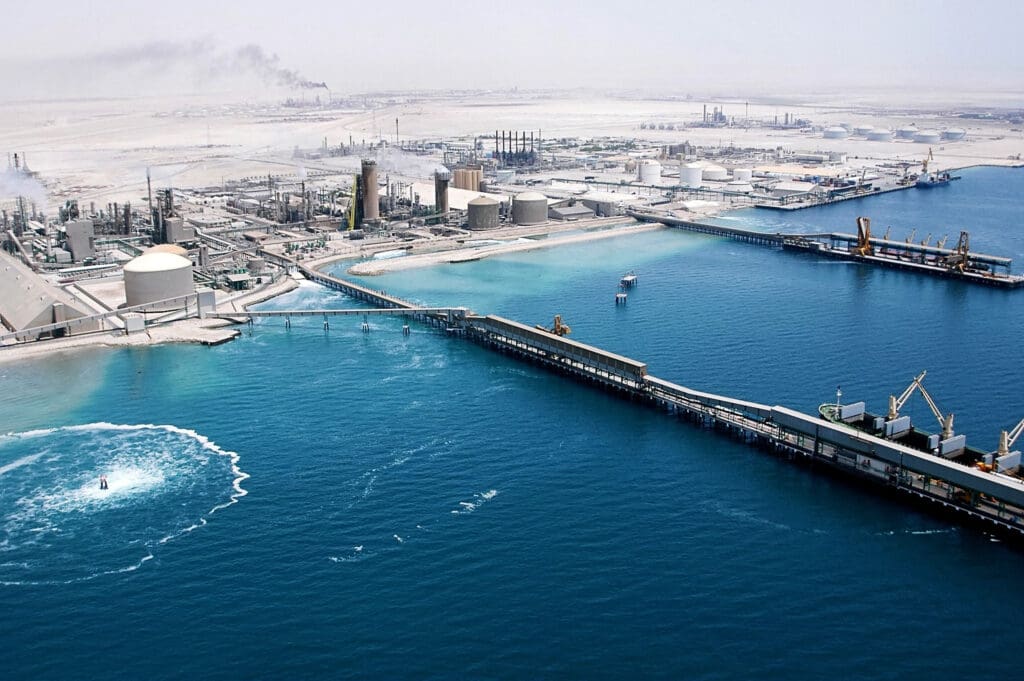Qatar is poised to nearly double its liquefied natural gas (LNG) production capacity—from 77 million tons per year (mtpa) to an ambitious 142 mtpa—by 2030. In an era defined by climate anxiety and calls to cut fossil fuel use, this expansion may seem counterintuitive. However, ramping up LNG exports can help major coal-reliant economies cut emissions in the near term, bridging the gap until renewables and other clean technologies take center stage. Still, questions remain over whether this is a savvy, strategic play for the Gulf state, or a high-risk gamble that could undermine global decarbonization goals, as well as its own.
Qatar’s LNG industry has long served as a force for coal-to-gas switching. Some experts have argued that from 2005 to 2020, it helped avert an estimated 600 million tons of carbon dioxide that might otherwise have been emitted had coal been used instead. During that period, fast-growing importers—including Japan, South Korea and emerging economies in Southeast Asia—embraced LNG to curb pollution and slow climate change. By virtue of its lower carbon intensity—roughly half the emissions of coal-fired power—LNG lowered global greenhouse gas totals while enabling robust economic expansion abroad.
This dynamic remains central to Doha’s pitch: By scaling up LNG output in Qatar’s massive North Field, it could accelerate coal’s decline in coal-heavy markets, particularly in Asia, and support Western Europe’s efforts to phase out coal. Across Asia, coal-to-gas conversions and the construction of new gas-fired power plants have gained traction as an interim step to reduce greenhouse gas emissions. In Asia, a switch to gas by just 20 percent of the region’s coal-fired power plants could lead to a reduction of 680 mtpa in carbon dioxide emissions. This has led policymakers in several Asian countries—particularly those with net-zero or carbon-neutral commitments, such as Japan and South Korea—to consider converting a portion of their coal units to gas to meet emissions targets.
Even in countries like India and China, where coal capacity continues to grow, gas-fired electricity generation can play a complementary role as local environmental pressures and international climate commitments drive the need for lower-emission options. China’s national state-run petroleum company, for instance, projected that coal’s share in the country’s energy mix could shrink to just 8 percent by 2060, down from about 44 percent expected in 2030. Natural gas—expected to rise to 12 percent of China’s total energy by 2030—will be one of the main bridges supporting this transition. India, the world’s fourth-largest LNG importer, aims to boost the proportion of natural gas in its energy mix from roughly 6 percent to 15 percent by the 2030. Meanwhile, other renewable energy policies around the region, if implemented effectively, could cut coal-based electricity generation by nearly a quarter.
Gambling on a Glut
Despite the logic of coal displacement, Qatar’s North Field expansions are coming online just as analysts warn of an impending LNG glut. Multiple projects in the United States, Russia, Canada and Africa could collectively raise global LNG capacity by at least 40 percent by the end of the decade. According to some forecasts, the oversupply may reach 6–13 percent around 2030, driving down prices and discouraging buyers from signing the kind of long-term contracts on which Qatar traditionally relies.
Why take this risk? In a world where lowering emissions wherever possible is a priority, Qatar’s ability to compete on price and emissions is an asset. Doha boasts exceptionally low production costs, enabling it to remain profitable even if market prices dip. Additionally, its central geographic position lets Doha redirect cargoes to whichever market offers better net value at any given moment, thus mitigating price volatility. Moreover, Qatar has perfected a strategy of tying buyers to its projects by offering them equity stakes, effectively securing demand for its LNG. This model has extended to the latest expansion phases where major international and energy firms hold shares.
Thus, the expansion positions Qatar to capture a larger market share. Doha’s strategic thinking is shaped by its cost advantage, established brand and flexible export model. Qatar can tolerate periods of oversupply or price dips better than higher-cost competitors. By the end of the decade, if demand holds steady or rebounds, Doha could lock in another round of long-term contracts. The very real possibility remains that countries transitioning from coal will come to see LNG not as an adversary to renewables, but as a necessary partner to ensure reliable baseload power, grid stability and a near-to-medium term reduction in carbon emissions.
Climate Caveats
In principle, LNG’s climate benefit is clear-cut when it replaces coal. But this equation depends heavily on controlling methane leaks and lifecycle emissions. If upstream facilities vent or flare gas excessively, LNG’s comparative advantage shrinks. Doha acknowledges this risk. QatarEnergy has committed to eliminating routine flaring, upgrading infrastructure to detect fugitive emissions and installing carbon capture utilization and storage (CCUS). According to official statements, the company aims for a 35% reduction in carbon intensity at LNG facilities and at least a 25% reduction in upstream facilities by 2035, while targeting a methane intensity of 0.2% by 2025. That said, the Ras Laffan CCUS facility is the largest CO₂ recovery and sequestration plant in the Middle East and North Africa, with a current capacity of 2.1–2.2 million tons of CO₂ per year; and aims to expand it to 7–9 million tons per year by 2030 and over 11 million tons per year by 2035.
Yet a broader critique centers on the question of long-term lock-in. Every new LNG terminal or pipeline built today could potentially slow the shift to lower-carbon sources. Environmental advocates worry that decades-long gas contracts might crowd out renewables—particularly in lower-income nations that struggle to finance new gas projects alongside large-scale wind or solar ones. For Qatar, the challenge requires threading a needle: expanding LNG so that it actively displaces coal, without inadvertently delaying investment in green infrastructure. Doha’s stance is that gas offers essential stability for grids in which renewables alone cannot yet meet peak demand. In this sense, LNG becomes a near-term solution that buys time for solar and wind to scale.
Qatar’s Climate Commitments
By 2030, Qatar aims to reduce its domestic greenhouse gas emissions by 25 percent compared to business as usual. Critics note that this is not an absolute cap; the country has yet to commit to a net-zero target, which is increasingly the global norm. That gap raises eyebrows: How can a nation set to more than double its gas production also credibly align itself with the world’s push to limit warming to 1.5 or 2 degrees Celsius?
It could be argued that bolstering LNG exports might raise the emissions to some extent. However, Doha is investing in solar power, electrifying transportation and improving industrial efficiency to keep domestic emissions in check. Nonetheless, for those demanding every major energy producer adopt a net-zero plan, Doha’s reluctance signals a careful balancing act by maintaining its leading role in LNG while staying relevant to a future decarbonized economy.
Boon or Bane for a Sustainable Future?
Qatar’s North Field expansion underscores a tension at the heart of today’s energy debate. On the one hand, the world needs rapid, sweeping decarbonization to avert climate catastrophe. On the other hand, many nations heavily dependent on coal still require an interim step—especially if renewables alone cannot meet soaring demand in the short run. Qatar’s LNG helps fill that gap, offsetting substantial emissions when used in lieu of coal and supporting economic growth in emerging markets. Coupled with Qatar’s cost advantages and environmental safeguards, this expansion is impeccably timed to accelerate coal’s decline and trim global carbon output in this decisive decade.
Nevertheless, Doha’s strategy hinges on nuanced execution. Efforts to prevent methane leakage and eliminate flaring must be rigorous to preserve LNG’s relative climate advantage. Domestically, a more robust, absolute emissions target—and an eventual net-zero roadmap—would mitigate doubts about the country’s commitment to the long-term energy transition. Qatar and other LNG producers should calibrate their plans for new gas infrastructure to ensure they do not stifle renewable deployment.
Ultimately, Qatar’s vision for LNG will rise or fall on whether it truly serves as a stepping stone to a low-carbon future, helping wean the world off coal without chaining us to another fossil fuel. For now, at least, Doha’s bet appears well-calculated to shape the global energy landscape heading into 2030.


